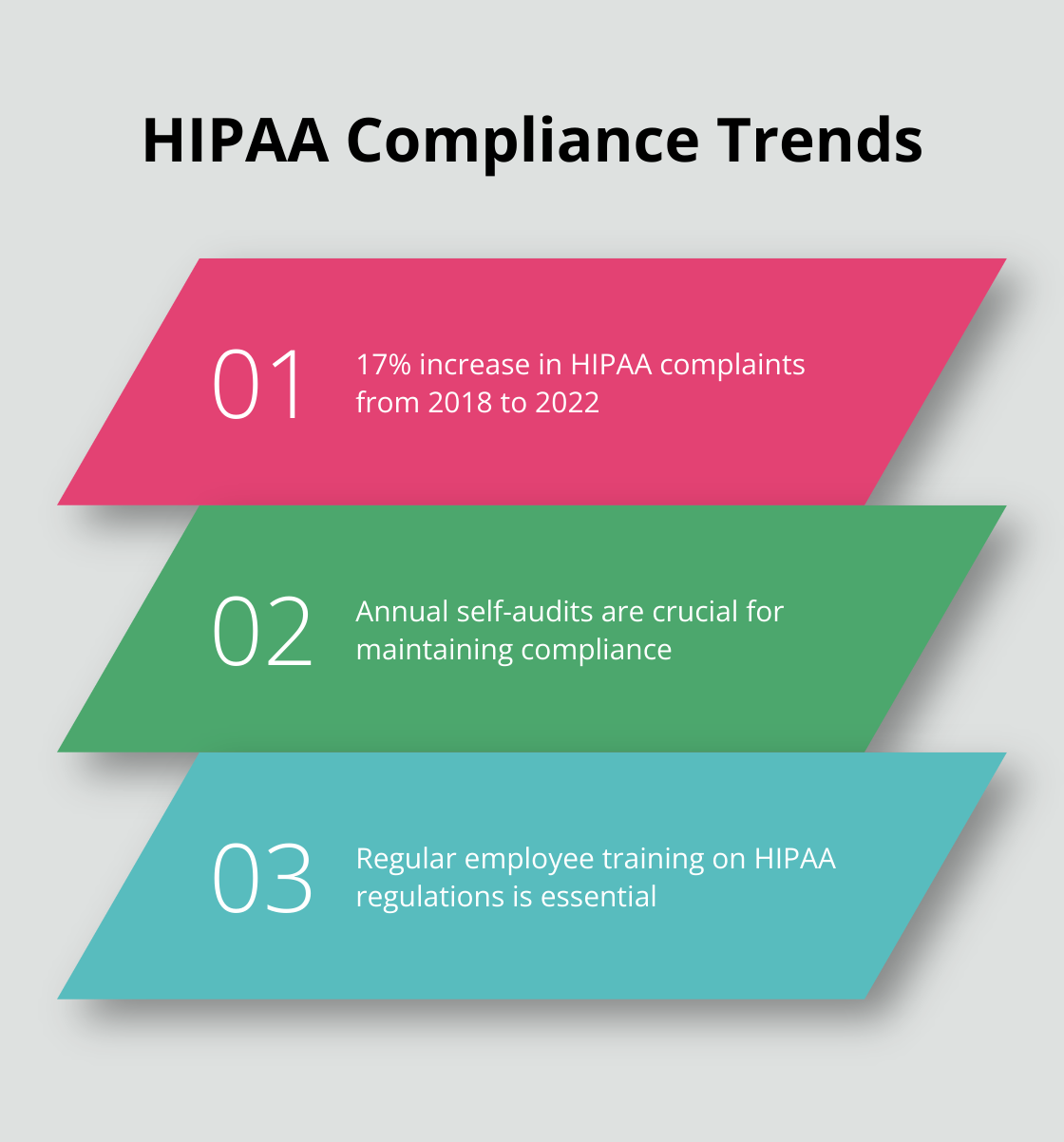Alright, folks, let’s talk data—sensitive patient data. We’re dealing with stuff so private that even the thought of it getting out makes us break out in a cold sweat. It’s not just about keeping up with the law (though, yeah, that’s non-negotiable) but about doing the right thing. It’s a moral compass kind of deal.
Here’s the real talk at ScriberJoy: we get it. We know that transcription security in the wild world of healthcare isn’t just critical—it’s life and death critical. What follows is a no-nonsense dive into the top-notch security measures that every medical transcription service worth its salt must have on lock. Why? To keep patient info on the down-low and ensure that trust in the healthcare system doesn’t just survive… but thrives.
How We Protect Patient Data
At ScriberJoy, data protection isn’t just something we do… it’s a solemn promise. Forget about checking boxes-this is about guarding the intensely private stuff people share with us. So, let’s unpack how we keep the vault sealed on patient data.
Encryption: The First Line of Defense
End-to-end encryption-there it is, the gatekeeper. This ensures the data is all wrapped up nice and tight, both when flying around and when parked. We’re talking HTTPS, SSL… the works. For medical transcription, this isn’t optional; it’s the absolute must-have to shield sensitive info.
Secure Storage: Keeping Data Safe at Rest
When data’s not sprinting down the wire, it needs a fortress to chill in. Enter secure cloud storage with a network of redundancies-think of it as data having a summer home, winter retreat, and a few safe houses. Backups galore, each spot more secure than the next.
Access Control: The Right Eyes Only
Not everyone needs to be in the inner circle. Role-based access control-it’s like a velvet rope at an exclusive club. Job roles dictate who sees what, ensuring nobody’s poking around where they shouldn’t. It’s not just smart; it’s mandated by the big guys in security standards to shield certain health info.
Transmission Protocols: Safe Travels for Data
Data on the move is data at risk. Secure file transfer protocols step in, creating an invisibility cloak-pardon the Hogwarts reference-for data zipping through cyberspace. No peeking from the nosy neighbors!
Continuous Monitoring: Always on Guard
Security isn’t some microwave dinner you just set and walk away from. Nope, it’s a living, breathing beast. Real-time monitoring tools are like the bouncer that never sleeps, ready to tackle any funny business before it gets inside.
These ironclad security strategies are the bedrock of reliable medical transcription services. But wait… there’s more. Taking it up a notch, we’ve got to chat about compliance with regulatory standards, especially the big kahuna-HIPAA. Stick around to see how playing by these rules cranks up the safety dial on sensitive patient data to eleven.
HIPAA Compliance: The Cornerstone of Medical Transcription Security
HIPAA compliance-it’s like the DNA of medical transcription security. The Health Insurance Portability and Accountability Act? Yeah, that’s the golden rulebook for safeguarding those sensitive patient tidbits. For transcription services, HIPAA is the game plan… the framework that dictates every move. Non-negotiable.
The HIPAA Rulebook: Privacy and Security
Meet the backbone-HIPAA’s Privacy Rule and Security Rule. The Privacy Rule? That’s all about the who and how of sharing Protected Health Information (PHI). Translation: transcription services need ironclad safeguards letting only the VIPs through to access PHI. Then there’s the Security Rule, which is laser-focused on digital PHI (ePHI) protection-think tech locks, strong doors, and super admin protocols.
The Department of Health and Human Services reported a 17% increase in HIPAA complaints from 2018 to 2022-hello, wake-up call for the transcription world to tighten up their compliance game.

Audits and Risk Assessments: Proactive Protection
Audits and risk assessments-think of them as your compliance life jacket. The Office for Civil Rights (OCR) doesn’t mess around; they pop in with audits to keep everyone in line with HIPAA. Flashback to 2022, when the HHS Civil Rights Office wrapped up HIPAA Right of Access probes and inked some settlements.
Transcription services, heads up: self-audit every year! Scrutinize every data-handling step, from the first touch to the final farewell. Risk assessments? Your crystal ball for spotting weak spots before they become headline breaches.
Employee Training: Building a Human Firewall
Sure, technology’s the cool kid on the block, but the human element? Can’t overlook that. Training the team on privacy and security is key-like building a human firewall. Training should cover:
- A deep dive into HIPAA regulations and what they mean
- Spotting and reporting security red flags
- Mastering the art of handling PHI in all its forms
- Leveraging encryption and secure chats
- Crisis playbooks for when things go south
Training isn’t a one-and-done deal. Keep it fresh… quarterly sessions ensure the crew’s always on their A-game with the latest HIPAA know-how.
Continuous Improvement: Adapting to Evolving Threats
In the world of cybersecurity, threats don’t sit still-gotta stay nimble. Translation: transcription services need to be in the know about the latest security buzz, keep their digital tools sharp, and adjust protocols based on new intel.
By prioritizing HIPAA compliance through solid policies, frequent audits, and top-notch training, transcription services don’t just dodge those nasty fines-they fortify trust with healthcare folks and their patients.
Onward-next up, we dive into secure authentication and access management. Think of these as the dynamic duo partnering with HIPAA compliance to wrap sensitive patient data in a fortress.
Secure Authentication and Access Management: Fortifying Medical Data Protection
Multi-Factor Authentication: The New Standard
So, Multi-factor authentication (MFA)… it’s now the gold standard in access security. Why? It mixes a cocktail of verification methods:

What does this concoction do? Makes life a whole lot harder for anyone trying to break in-because even if they crack your password, they’re still stuck at the gate.
Robust Password Policies: The Foundation of Security
Strong passwords… still the bread and butter of data protection. Here’s what a rock-solid password policy looks like:

Real-Time User Activity Monitoring
Keep your eyes open-continuous monitoring is your partner-in-crime against breaches. These tools? They’re like having a watchdog on duty 24/7. They’ll:
- Spot weird login patterns or sketchy access attempts
- Help sniff out potential insider threats
- Keep thorough audit trails, which is gold for compliance
Role-Based Access Control
And then there’s Role-based access control (RBAC)-the principle of least privilege, people! RBAC isn’t just a fancy acronym; it keeps your data where it belongs and:
- Limits access to sensitive info
- Makes user rights management a breeze
- Boosts your entire system’s security
Regular Security Audits and Updates
Lay it all on the table-security isn’t “set it and forget it.” Nope, regular audits are your bread and butter to find those pesky vulnerabilities and keep protocols sharp. This rigorous routine includes:
- Pouring over access logs
- Stress-testing authentication systems
- Bringing security policies up to code
- Patching up those software leaks
All these solid authentication and access steps… they pave the way for healthcare pros to zero in on patient care without a security hang-up. (A quick nod to ScriberJoy, for those who want security that doesn’t flinch, alongside unmatched accuracy in medical transcription.)
Final Thoughts
Transcription security – it’s the bedrock of trust between doctors and patients. Think of it as a digital fortress (with encryption galore, all the HIPAA bells and whistles, and top-notch authentication) guarding sensitive patient info. But here’s the kicker – you can’t just set it and forget it. You’ve got to stay on your toes with regular updates because, let’s face it, the digital landscape changes faster than a teenager’s mood.
Now, security in medical transcription doesn’t just keep you out of legal hot water. Oh no, it does wonders for trust, boosts the rep of healthcare providers, and at the end of the day, makes for happier, healthier patients. When docs can zero in on patient care without sweating a data breach, everyone wins.
Enter ScriberJoy. They’ve cracked the code on transcription security. Marrying AI tech with the keen eye of human verification, they churn out medical documentation with a jaw-dropping 99% accuracy. Security, accuracy, efficiency – they juggle all three, letting healthcare pros breeze through the paperwork and focus on what really matters: patient care.

Leave a Reply
You must be logged in to post a comment.